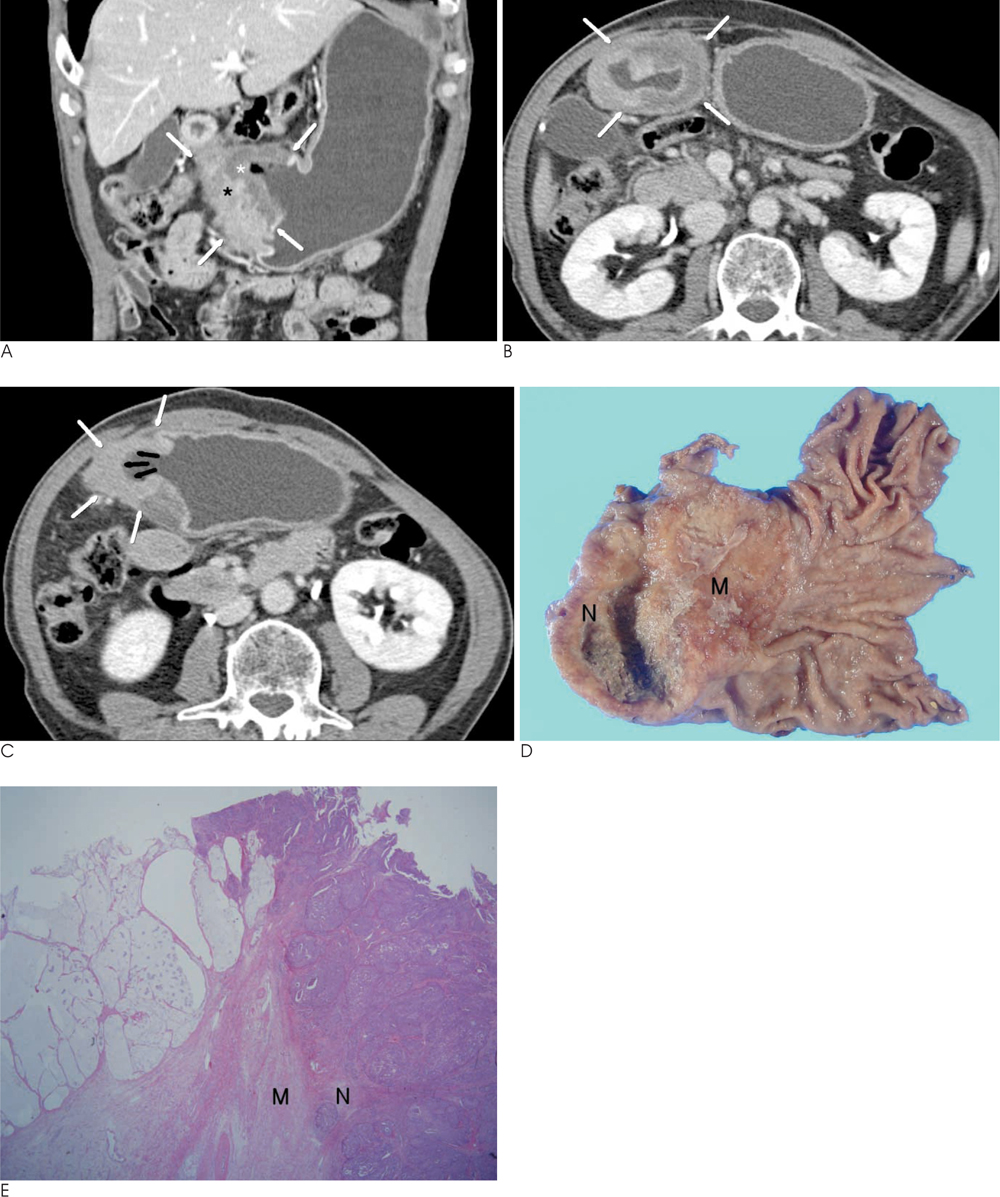J Korean Soc Radiol.
2010 Sep;63(3):239-243. 10.3348/jksr.2010.63.3.239.
Gastric Collision Tumor Consisting of Mucinous Carcinoma and Large Cell Neuroendocrine Carcinoma: A Case Report
- Affiliations
-
- 1Department of Radiology, Bundang Jesaeng General Hospital, Korea. leechoii@paran.com
- 2Department of Pathology, Bundang Jesaeng General Hospital, Korea.
- KMID: 2097899
- DOI: http://doi.org/10.3348/jksr.2010.63.3.239
Abstract
- The concurrence of two different pathological tumors of the stomach is infrequent. Even rarer is a gastric collision tumor of both tumor types. Although there have been a few reported cases of gastric collision tumors that consisted of an adenocarcinoma and neuroendocrine carcinoma, to the best of our knowledge, there is no documented case report of a gastric collision tumor consisting of a mucinous carcinoma and large cell neuroendocrine carcinoma. We report a case of gastric collision tumor, consisting of a mucinous carcinoma and large cell neuroendocrine carcinoma that presented as abdominal discomfort in a 64-year-old man. This finding draws attention to the related findings from previous studies on gastric collision tumors.
MeSH Terms
Figure
Reference
-
1. Park MS, Yu JS, Kim MJ, Noh TW, Lee KH, Lee JT, et al. Mucinous versus nonmucinous gastric carcinoma: differentiation with helical CT. Radiology. 2002; 223:540–546.2. Park BS, Jo TY, Seo HI, Kim HS, Kim DH, Jeon TY, Kim DH, Sim MS, Kim JY. Gastric Collision Tumor (Adenocarcinoma and Neuroendocrine carcinoma) Diagnosed as a Advanced Gastric Cancer. J Korean Surg Soc. 2007; 73:173–177.3. Kwak HS, Lee JM, Lee YH, Kim YK, Kim CS. Gastric neuroendocrine carcinoma presenting as a wandering exophytic mass: a case report. J Korean Radiol Soc. 2002; 47:217–220.4. Kim HS, Hong SS, Kim JH, Jin SY, Choi DL, Kim YJ, Kwon KH. CT Gastrography Findings of a Gastric Collision Tumor that Consisted of an Adenocarcinoma and Neuroendocrine Tumor: A Case Report. J Korean Radiol Soc. 2007; 57:463–466.5. Kim EY, Park KC, Kwon JG. A case of double primary cancer: early gastric adenocarcinoma associated with adenocarcinoma and carcinoid. Korean J Gastroenterol. 2003; 42:533–538.6. Hirano Y, Hara T, Nozawa H, Oyama K, Ohta N, Omura K, et al. Combined choriocarcinoma, neuroendocrine cell carcinoma and tubular adenocarcinoma in the stomach. World J Gastroenterol. 2008; 14:3269–3272.7. Liu SW, Chen GH, Hsieh PP. Collision tumor of the stomach: a case report of mixed gastrointestinal stromal tumor and adenocarcinoma. J Clin Gastroenterol. 2002; 35:332–334.8. Kim HJ, Choi DG, Lee SJ, Lee WJ, Kim S, Kim JJ, et al. Four cases of large cell neuroendocrine carcinoma of the stomach: findings on CT and barium studies. A case report. J Korean Radiol Soc. 2008; 58:607–612.9. Choi JS, Kim MA, Lee HE, Lee HS, Kim WH. Mucinous gastric carcinomas: clinicopathologic and molecular analyses. Cancer. 2009; 115:3581–3590.10. Jung JH, Kim AY, Kim HJ, Yook JH, Yu ES, Jang YJ, Park SH, Shin YM, Ha HK. Multidetector CT of Locally Invasive Advanced Gastric Cancer: Value of Oblique Coronal Reconstructed Images for the Assessment of Local Invasion. J Korean Soc Radiol. 2010; 62:47–55.
- Full Text Links
- Actions
-
Cited
- CITED
-
- Close
- Share
- Similar articles
-
- Ovarian Large Cell Neuroendocrine Carcinoma Associated with Endocervical-like Mucinous Borderline Tumor: A Case Report and Literature Review
- Pancreatic Collision Tumor of Desmoid-Type Fibromatosis and Mucinous Cystic Neoplasm: A Case Report
- A Case of a Collision Tumor in the Ampulla of Vater with an Adenocarcinoma and a Large Cell Neuroendocrine Carcinoma
- Gastric Collision Tumor (Adenocarcinoma and Neuro-endocrine Carcinoma): A Report of Two Cases
- Large cell Neuroendocrine Carcinoma Associated with Invasive Mucinous Adenocarcinoma of the Uterine Cervix


